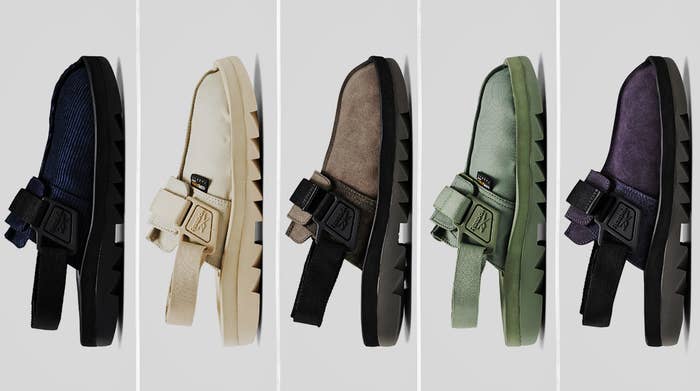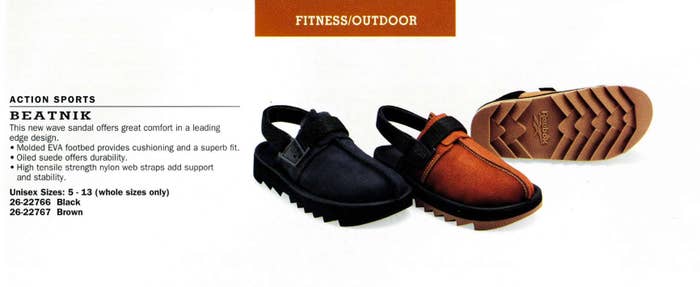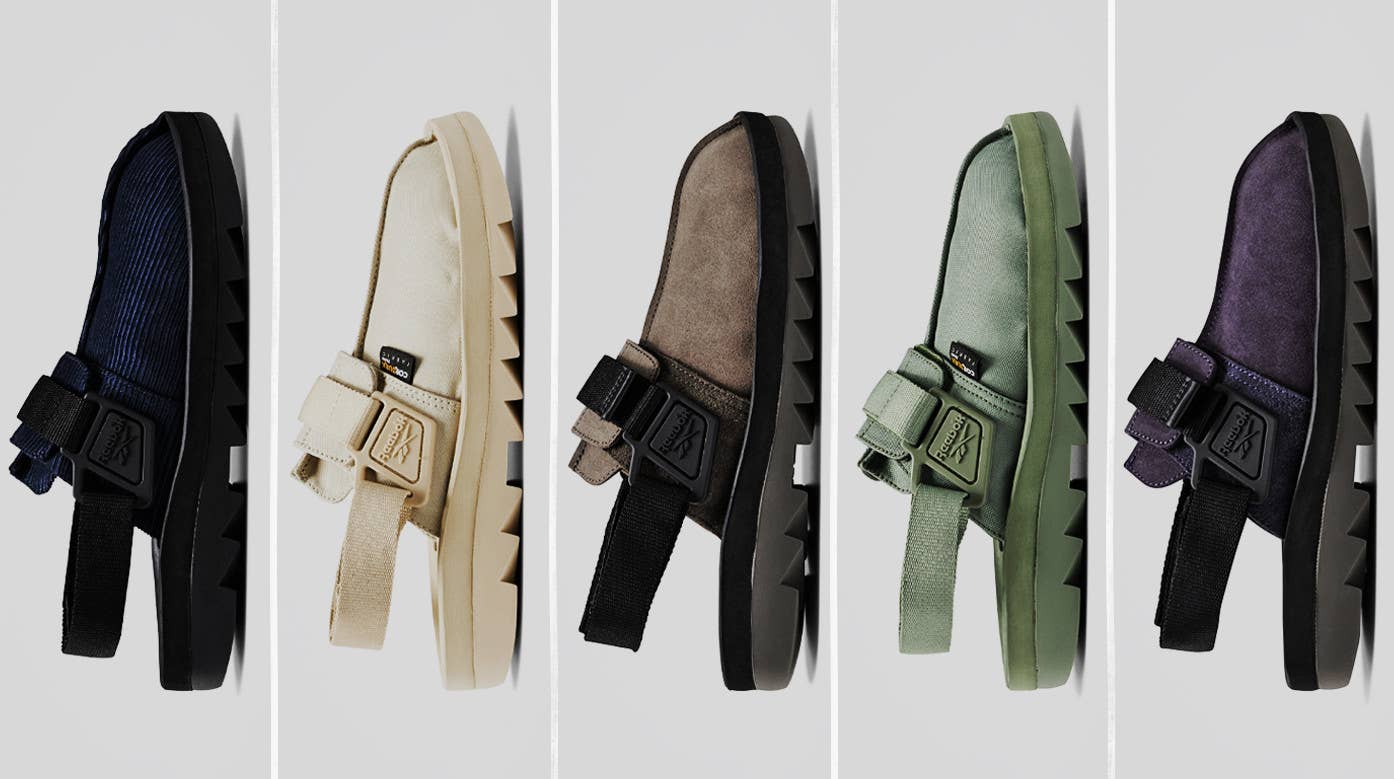
Despite the fact that it’s loved by sneaker enthusiasts, the Reebok Beatnik isn’t really a sneaker. And although Reebok officially calls it a sandal, the shoe doesn’t have much in common with traditional open-toed footwear either. The Beatnik is more of a hybrid design, one that boasts the foot-hugging feel and look of a cozy slipper while retaining some elements of an athletic shoe—most notably its rippled, shark tooth sole. The clog-like shoe feels tailor-made for our current at-home situation, but it isn’t a carefully timed reaction to quarantine. Instead, it’s one that’s been tucked away in Reebok’s archives for years, a shoe that has long been embraced by fashion-forward residents of Japan but was seldom seen in other parts of the world, until now.
Designed by Nick O’Rorke, who worked as Reebok’s creative director of footwear trends from 1990 through 1997, the Beatnik was introduced as part of Reebok’s Fall 1994 Outdoor line. “Originally made in Brazil and released in the West, it gained cult status in Japan, where traveling footwear enthusiasts bought the Beatniks overseas and brought them back to Japan,” says Stephanie Schaff, senior archive specialist at Reebok.
Purposed as an action sports shoe alongside a handful of aquatic sandals such as the Amazone and Zambezee, the Beatnik was more apropos for the trails than it was any body of water. Its original product description calls it a “new wave sandal,” emphasizing its on-the-nose model name that references the laid-back counterculture movement of the late ‘50s and early ‘60s. The upper of O’Rorke’s design is part-slipper, part-sandal, with a split seam (reminiscent of the Clarks Desert Trek) running up the oiled suede toe and vamp before breaking into an adjustable open-heel Velcro configuration.

With a lot already happening compared to your average pair of slides, one of the Beatnik’s standout features is the aforementioned dual-compound sole. Underfoot, there’s a molded EVA footbed that becomes more comfortable as the shoes get broken in, and that’s finished off with a harder rubber outsole complete with an exaggerated, jagged tread. The Beatnik name, and the shoe’s easygoing clog-like fit, are somewhat deceiving thanks in large part to the shoe’s rippled sole, which can withstand repeated use on both the pavement and dusty paths. In fact, the Beatnik is as functional today as it was in the early ‘90s, but back then, it proved to be ahead of its time in the U.S.
Upon its release, the Beatnik didn’t exactly take off stateside. It wasn’t that it was unsuccessful, but the sneaker-sandal mashup ended up finding greater success in a country where it wasn’t even originally available: Japan. Stylish inhabitants of Tokyo neighborhoods like Aoyama and Ura-Harajuku, many of whom tended to favor sandals and laceless slip-on style sneakers like Reebok’s own Instapump Fury, took a liking to the Beatnik’s unique design and exclusivity. The shoe wasn’t available in the country early on, but that didn’t stop Japanese diggers from discovering it while traveling abroad and bringing an abundance of pairs back home.
Although it caught on with the Japanese in the ‘90s, the Beatnik’s visibility faded in America throughout the decade and by the time the millennium approached, the shoe was all but forgotten here. It would remain dormant throughout the 2000s and much of the 2010s. Perhaps it was too ahead of its time—possibly even pulled from production too soon—as similar pairs from other brands would later gain traction in the U.S.
Artisan Japanese menswear brand Visvim’s Christo sandal, first released in 2003, uses a similar, albeit open-toed, construction, right down to the rugged textile uppers and Velcro fastening straps. A more mainstream example is the ubiquitous Crocs clog, which hit the market in 2004 and has a silhouette that resembles the Beatnik thanks to its rounded toe and heel strap. That’s not to say that either the Christo or Crocs were directly inspired by the Beatnik, but it’s worth noting that Reebok’s shoe preceded these similar concepts by nearly a decade.

Fittingly, the Beatnik’s reintroduction catered to the region that was most fond of its original run. A trio of Japan-exclusive colorways (black, grey, and tan) released in March 2018, but that would only whet appetites for what would really kick off the Beatnik hype later that year. In December ’18, Reebok called upon storied Japanese retailer Beams and cult favorite Needles for a three-way collaboration on the sandal. Draped in all black, the Needles x Beams x Beatnik featured Needles’ signature butterfly logo embroidered in purple, but was otherwise devoid of any special branding or callouts. It was also limited as hell, releasing only in Japan at Beams, Nepenthes, and select retailers.
"Once the Needles Beatnik launched at the end of 2018, that's when the global surge started and that's when Europe and the U.S., they really started to take part and appreciate the model,” says Leo Gamboa, senior global product marketing manager of collaborations at Reebok. “That's kind of like the early, early start of, I think, when the hype really began.”
Gamboa says the buzz around the collaboration caused the inline versions of the Beatnik to sell out quickly too. This trend continued in 2019, which saw four additional Japan-exclusive styles hit the market in limited fashion. Before long, the phenomenon of Japanese buyers hunting down pairs from other countries had been reversed. This time around, people in the U.S., Europe, and elsewhere were scavenging sites like eBay and Yahoo! Japan in hopes of stumbling upon the elusive sandals.
“I think anyone who is an enthusiast or a sneaker guy loves the idea of a hunt,” Gamboa says. “It kind of helps, it’s part of the fun, it's part of the culture. Once you kind of get the product, it's not just buying the shoes, it's actually the whole process of trying to get it. It's a whole thing.”

With a hard-to-find collab and Japan’s sartorial seal of approval in tow, the Beatnik was primed for its reemergence in the States and beyond. Gamboa helped lead the shoe’s 2020 retro strategy, which has seen various different materials including durable Cordura, Birkenstock-inspired corduroy, and OG-style suede. The Beatnik’s also been delivered in a gamut of earth tone colorways, along with new collaborations with the likes of Brain Dead and Pleasures. A project with London label Story Mfg is in the works for Spring/Summer 2021, but Gamboa stresses that Reebok has been selective with its partners for the model.
“We definitely are minimizing the collaborations on this model, we don't want to oversaturate it in the marketplace,” Gamboa says. “We want the partner that works on this to actually have a connection to the shoe and not just want to jump on something for trend. So we've been very specific on who works on it.”
As the Beatnik’s banner year comes to a close, a U.S. release is on the way for three new suede colorways in patchwork cuts of varying shades and textures. Like the aforementioned Pleasures collaboration, this latest drop is unique in that it features a removable heel strap, allowing the shoe to be worn as a mule. Each of the three pairs are available now from Reebok’s U.K. site and will receive a stateside release soon. As for what’s in store for 2021, Gamboa is tight-lipped, but he noted that fans can expect drops throughout the year.
“I think everyone will be pretty excited when they see [what’s coming],” Gamboa says.

